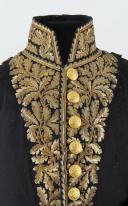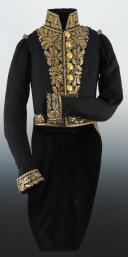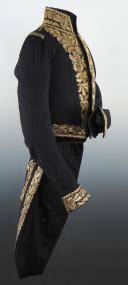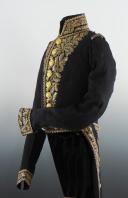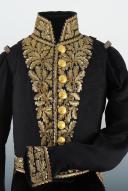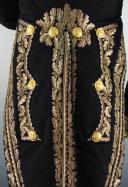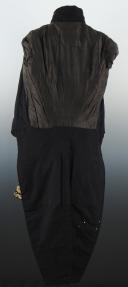
LIEUTENANT-GENERAL'S CEREMONIAL DRESS THAT BELONGED TO THE DUC D'AUMALE, model 1830, July Monarchy.
LIEUTENANT-GENERAL'S CEREMONIAL DRESS THAT BELONGED TO THE DUC D'AUMALE, model 1830, July Monarchy.
National blue cloth coat lined in the same way, without lapels, buttoning straight on the chest to the waist, releasing on the side of the thigh and not crossed behind. The collar is made of national blue cloth 6.4 cm high. The facings of the same sheet are cut, H 6.4 cm, they close over with a small uniform button (diameter 1.7 cm).
The panels are drooping and stapled behind, folded and sewn on themselves.
At the front on the right side, the coat is trimmed with nine large half-domed uniform buttons (diameter 2.5 cm), placed at equal distance from the base of the collar to the height of the belt, one at each hip.
The uniform buttons of the generals are in over-gilt brass, they are stamped in relief with a shield stamped with a Gallic rooster with a laurel wreath placed on a lictor's bundle wearing a plumed helmet, with a bundle in the background of flags and the winged spindle of Jupiter. These buttons are mounted on brass.
The fronts of the coat, the panels at the back, the collar and the facings have an embroidery 5.4 cm wide including the serrated strip, in the upper part this embroidery increases to reach 14 cm; at the shoulders, the embroidery is reduced to 1.8 cm.
On the collar and facings, the embroidery is completed with a second branch of oak leaves distinguishing the rank of general of division. The whole of this embroidery measures 6.3 cm on the collar and 6.2 cm on the facings. This embroidery represents an oak branch, it is made of gilded silver threads, in the past, with very small sequins on the sides of the leaves and on the wand. The body of the branch and the fillet of the wand are embroidered in crimps of twists.
In the four corners of the lapels of the back panel, a flaming winged bomb is embroidered directly on the uniform cloth in threads, sequins, sequins and trimmings and scarlet silk threads. H 6.2 cm, width 4 cm.
At the level of the shoulders, near the collar is sewn a small loop in blue cloth intended to receive the hook of the epaulettes. Near the armhole of the shoulders, an epaulette loop in blue cloth, entirely embroidered in gold threads (length approximately 9.5 cm, width 1.5 cm) is sewn.
At the back, two false pockets with three vertical points are entirely embroidered (width 6 cm in the lower part, 8.5 cm in the upper part), each point is furnished with a large uniform button. Similarly, the waist knot is embroidered with oak leaves completed with two uniform buttons.
The interior lining in national blue cloth is completed with black silk on the back and sleeves.
At the front, at the level of the chest on the left side, eight small loops woven in black silk threads 1 cm wide are sewn to receive the various insignia and decorations.
Near new condition, a few tiny moth holes, the embroidery and gilding have kept all their shine.
France.
July Monarchy.
NOTE :
The denomination of lieutenant-general is again used instead of "general of division" under the Restoration and the July Monarchy and disappears definitively in 1848.
ORIGIN :
This uniform comes from the sale of historical souvenirs of the estate of Prince Henri d'Orléans, Count of Paris, on October 30, 2010 at the Hôtel des Ventes Drouot in Paris, Etude Nicolay, lot n° 182.
BIOGRAPHY :
Henri d'Orléans, Duke of Aumale, born January 16, 1822 in Paris and died May 7, 1897 in Giardinello (Italy), blood prince of the House of Orleans, son of King Louis-Philippe, was a soldier and a French politician, who was notably Governor General of Algeria and as such participated in the surrender of Abd el-Kader in December 1847.
He was also one of the first bibliophiles and collectors of ancient art of his time.
Childhood
He is the fifth and penultimate son of Louis-Philippe I, King of the French, and Marie-Amélie de Bourbon, Princess of the Two Sicilies.
The affair of the inheritance of the Prince of Condé (1830)
In 1830, on the death of the last Prince of Condé, his godfather, who made him his universal legatee, he inherited, at the age of eight, the enormous heritage of this line, estimated at 66 million gold francs, producing 2 million annual revenue. This heritage includes what is considered to be the most important French land heritage, including the Chantilly estate (Oise) and immense forests in Thiérache (Aisne).
The far-left deputy Eusèbe de Salverte challenges the Ministry on the payment of the rights of this succession.
The Director of Registration, Jean-Louis Calmon, replies that these rights had not yet been settled, "the Government always granting time limits for the payment of rights when it is found that the heirs do not have the ways to pay them. […] this is the case here, these rights amounting to more than four million. There was no security in the estate. The liquidators of the estate tried to take out a loan without succeeding; they have just put up for sale nine thousand arpents of wood and, before long, the duties will be settled”.
Training
This section is empty, insufficiently detailed or incomplete. Your help is welcome !
He did his secondary studies at the Henri-IV college in Paris, then joined the army at the age of sixteen.
The July Monarchy
Military career: Algeria (1840-1847) The Duke of Aumale attacks the Smalah at Taguin on May 16, 1843 by Édouard Detaille.
Second lieutenant in 1839, he left for Algeria in 1840 and participated in the battle of Affroun (April 27), but had to return to France the following year for health reasons, with the rank of lieutenant-colonel of the 17th Light.
He returned to Algeria in September 1842 with the rank of maréchal de camp (brigadier general) and distinguished himself during the capture of the smala of Abd El-Kader (May 16, 1843).
Following this campaign, he was promoted to lieutenant-general (general of division) on July 3, 1843 and appointed commander of the province of Constantine. He led the Biskra expedition (1844) and took part in the pacification of the Aures: at the head of Colonel Mac Mahon's legionnaires, he captured the position of M'Chouneche.
His marriage and his children
Mary Caroline of Bourbon (1822-1869)
In 1844, he married his first cousin Marie-Caroline de Bourbon-Siciles, Princess of the Two Sicilies. They have seven children, of whom only two sons reach adulthood:
Louis-Philippe Marie Léopold (Saint-Cloud, November 15, 1845 - Sydney, May 24, 1866), titled Prince of Condé;
François Louis Philippe Marie (Twickenham, January 5, 1854 - Paris, July 25, 1872), "Duke of Guise".
Rumor has it that Gustave Macon (1865-1930), private secretary to the Duke of Aumale was his natural son, as he was born during the Duke's exile in England.
Governor General of Algeria (September 1847 – February 1848)
He succeeded Bugeaud as Governor General of Algeria on September 21, 1847.
On December 24, 1847, in Nemours, near the Moroccan border, he came to receive the surrender of Abd el-Kader. He confirms the commitment made the day before by General Lamoricière, commander of the Oran division, that the Emir would be taken to Alexandria or Saint-Jean d'Acre, a commitment which will not be respected, given the situation. politics in France.
exile in England
He resigned from his post after the Revolution of 1848 and went into exile in England (February 24, 1848) where, upon the death of Louis-Philippe I (1850), he moved to Orleans House, near Twickenham.
It is a “large castle of disparate style more comfortable than sumptuous, where his father had lived during the emigration; his brothers also occupied apartments in the huge residence. A beautiful park, the Thames nearby, the possibility of installing a library, a meditation asylum, a “reception” large enough to be able to create a welcoming atmosphere: a French name adopted from the outset”.
“He is rich, he is industrious (…) very well regarded in the great English world… Among the princes of Orléans, he is the only one whose life is well arranged, and who manages it” (François Guizot, 1847).
Several photographs of this house and of the duke, alone or in a group, are reproduced in the family album of his homonymous great-grandnephew Henri d'Orléans (1908-1999), count of Paris5. As well as one of the twelve shots taken in June 1864 by the photographer Camille Silvy (1834-1910), under number 61 of the catalog of the exhibition English art in the collections of the Institut de France.
His residence is close to the famous Strawberry Hill, former neo-Gothic residence of Horace Walpole, aesthete and collector; the duke became a close friend of its owner, Frances, wife of the 7th earl of Waldegrave, descendant of the heirs of Walpole, who bequeathed to him in 1879 a double portrait which the latter commissioned from Reynolds in 1761.
During this period, he devoted himself to writing historical narratives. He is the author of a History of the Princes of Condé and research on The Captivity of King John and The Siege of Alésia, as well as studies on The Zouaves, The Hunters on foot and Austria, published in the Revue des deux Mondes.
However, from the start of his exile he wrote to his teacher and friend Guérard: “England weighs on me, and the English even more. The heavy greenery of the country exceeded him, he was thirsty for clear light, for a landscape with bare lines", and in 1853 he acquired from the Prince of Partanna the domain of Zucco to the west of Palermo, i.e. "16 000 hectares producing honey, a precious wine - guarded day and night - 10,000 crates of lemons and 500 to 600 quintals of olives (...) Woods of centuries-old olive trees, Judas trees, bristling cacti, strange resinous, the aroma of lemon trees, orange trees, boxwood, laurels, carob trees, almond trees, a very simple house, vast but without luxury, a row of low whitewashed rooms (where) reigned a freshness perpetual, a paradise where he flourished. »
In 1861, in a pamphlet entitled Lettre sur l'histoire de France addressed to Prince Napoleon, he replied strongly to Prince Napoleon, cousin of Napoleon III, who, in a speech to the Senate on March 1, had attacked the members of the royal families accused to betray "their flag, their cause and their prince to gain false personal popularity". The pamphlet is seized, the publisher and the printer condemned.
In 1865, the imperial government also opposed the publication of the Histoire des princes de Condé, which finally appeared in 1869.
The return to France (1872)
In September 1870, he learned in Brussels from Jules Claretie of the disaster at Sedan and watched helplessly as the French army was routed; after having offered to fight, he returned to France with his brother the Prince of Joinville, but they were taken back to the boat.
On February 8, 1871 he was elected deputy for Oise, like his brother in Haute-Marne, but the hostility of Thiers pursued them.
At the end of 1871, the laws of exile of Napoleon III were brought back.
Resumption of his military career (1872-1879)
Reintegrated into the army in 1872 with the rank of general of division, he was appointed in September 1873 commander of the 7th army corps in Besançon.
The painter and caricaturist André Gill (1840-1885) represented him in the foreground on the right of his drawing-load entitled La Délivrance, evoking the loan of 3 billion launched by Thiers in July 1872 to liberate the national territory from the Prussians, alongside the ex-emperor holding the fallen eagle, and the Count of Chambord.
After the fall of Thiers on May 15, 1874, he was asked to accept the interim created by the law of the septennat to extend the mandate of Patrice de Mac Mahon, Duke of Magenta, in favor of the monarchical restoration project of his cousin the Count of Chambord, grandson of Charles X, but his candidacy was challenged by the right.
In 1879, he was affected by the series of layoffs which caused the resignation of Mac Mahon, but his friendship with Gambetta earned him the appointment of Inspector General of the Army, which was his last role as a soldier.
Bazaine's trial (1873)
On October 6, 1873 he presided, as dean of the generals of division, at the Grand Trianon of Versailles the council of war which judged Marshal Bazaine - commander-in-chief of the armies on August 13, 1870 - who on October 17 tried to explain his capitulation of Metz on October 27, 1870: “I no longer had a (legal) government; I was not directed by anyone, I was no longer directed except by my conscience...", to which the prince replied the famous: "France still existed".
The prince obtained from the President of the Republic that the death penalty be commuted to twenty years of detention at the request of the members of the War Council themselves: "You will join us, Mr President of the Republic, in order not to allow the execution of the sentence which we have just pronounced."
In 1879, appointed inspector general of the army corps, he remains on standby. With the other princes of the family who belonged to the army, he was placed on non-activity by retirement in 1883 and removed from the army in 1886. He left France a second time because of the exile law of 1886.
“The Duke of Aumale, there is only one word to describe him: he is the type of the old colonel of light cavalry. He has the slender elegance, the ravaged appearance, the greyish goatee, the baldness, the voice broken by command.
(Edmond and Jules de Goncourt, Journal, 1874).
The bequest to the Institut de France (1886)
In 1886, the Duc d'Aumale, a member of the Institut de France since 1871, a widower with no direct living descendants, bequeathed his domain of Chantilly (Oise) and its precious collections to the Institut on condition that upon his death, the Condé museum is open to the public, that its presentation is preserved and that the collections cannot be loaned. The Condé museum will be open to the public less than a year after his death on April 17, 1898.
According to the wish of the Duke of Aumale, the resources of the estate make it possible to operate, maintain and restore this immense heritage.
"Chantilly, as the duke wanted it, appears as an always accessible Atlantis (...) better than masterpieces, a total work of art".
Second exile and return
The Duke of Aumale photographed by Alphonse Liébert.
The 1886 law against the royal families of France
In 1886, General Georges Boulanger (1837-1891), Minister of War since January 7, undertook to transform the so-called professional army into a national army.
On June 11, the second exile law was passed following the resounding engagement reception of Princess Amélie d'Orléans at the Hôtel de Galliera in Paris on May 15; prevented from passing rue de Varenne by the long line of cars, the impatient Georges Clemenceau would then have said to Léonide Leblanc, mistress of the duke - and who was his -: “Tell him to beware. At the pavement that we are going to throw in the pond of his family, he could well be splashed "
In July he was removed from the executives on Boulanger's proposal by Jules Grévy, to whom he wrote: "it is up to me to remind you that the military ranks are above your reach", before being expelled to Belgium by the Director of Security on the 14th.
A collective demand for the recall of the exiled prince was sent to the government in 1888.
The return of 1889
He was authorized to return to France by decree of Sadi Carnot on March 8, 1889. The decree of banishment was reported on June 7, 1889.
On his return in 1889, he was elected Academician of Moral and Political Sciences on March 30. He was appointed director of the Academy of Besançon, honorary doctor of the University of Oxford and member of the Royal Academy of Brussels. From 1893 to 1897, he headed the Relief Society for Military Wounded (S.S.B.M.), which since 1940 has become the French Red Cross.
He had two villas built in the spa resort of Saint-Honoré-les-Bains, real small castles called: Le Pavillon Rose and Le Pavillon Blanc, now transformed into holiday cottages.
Death and funeral
“In the spring of 1897, he came to spend a few days at the Zucco (where) death took him by surprise, and none of his supreme wishes could be carried out. He is said to have died of a heart attack shortly after writing about twenty letters of condolence to families of the nobility bereaved by the fire at the Bazar de la Charité. But pious hands wrapped his coffin in the tricolor in the shadow of which he and his father had fought and which he waved over his exiled house”. Two photographs of the Duke aged and on his deathbed are reproduced in the Family Album of the Count of Paris.
On May 14, after having gone up from Palermo all over Italy, the body arrived at the Gare de Lyon in Paris and received on May 17 during the funeral at La Madeleine, at the request of his family, the military honors due to a great Cross of the Legion of Honor. But for a former general removed from the reserve cadre, this tribute did not include music or a parade, reserved for general officers in service... but, at the end of the ceremony, coming from the boulevard Malesherbes, paraded in front of the catafalque to the rhythm of the Sambre and Meuse march of troops in parade dress commanded by General Leloup de Sancy de Rolland, who saluted the coffin with the sword.
This was the ultimate public gesture towards the one to whom Victor Hugo, his colleague at the Academy, himself exiled by Napoleon III, wrote: “For me, your royalty has ceased to be political, and is now historic. My Republic does not care. You are part of the greatness of France and I love you” in his response to the notice of the Duke succeeding the Count of Cardaillat at the Academy of Fine Arts on July 17, 1880.
Proscribed twice by the government of his country, this patriotic friend of the Arts, by a generous gesture, nevertheless changed his will to a donation subject to usufruct (August 28, 1886) in order to enrich the national heritage with a unique artistic treasure. . “We celebrate at Chantilly an invisible and still living presence, despite the weather”.
National blue cloth coat lined in the same way, without lapels, buttoning straight on the chest to the waist, releasing on the side of the thigh and not crossed behind. The collar is made of national blue cloth 6.4 cm high. The facings of the same sheet are cut, H 6.4 cm, they close over with a small uniform button (diameter 1.7 cm).
The panels are drooping and stapled behind, folded and sewn on themselves.
At the front on the right side, the coat is trimmed with nine large half-domed uniform buttons (diameter 2.5 cm), placed at equal distance from the base of the collar to the height of the belt, one at each hip.
The uniform buttons of the generals are in over-gilt brass, they are stamped in relief with a shield stamped with a Gallic rooster with a laurel wreath placed on a lictor's bundle wearing a plumed helmet, with a bundle in the background of flags and the winged spindle of Jupiter. These buttons are mounted on brass.
The fronts of the coat, the panels at the back, the collar and the facings have an embroidery 5.4 cm wide including the serrated strip, in the upper part this embroidery increases to reach 14 cm; at the shoulders, the embroidery is reduced to 1.8 cm.
On the collar and facings, the embroidery is completed with a second branch of oak leaves distinguishing the rank of general of division. The whole of this embroidery measures 6.3 cm on the collar and 6.2 cm on the facings. This embroidery represents an oak branch, it is made of gilded silver threads, in the past, with very small sequins on the sides of the leaves and on the wand. The body of the branch and the fillet of the wand are embroidered in crimps of twists.
In the four corners of the lapels of the back panel, a flaming winged bomb is embroidered directly on the uniform cloth in threads, sequins, sequins and trimmings and scarlet silk threads. H 6.2 cm, width 4 cm.
At the level of the shoulders, near the collar is sewn a small loop in blue cloth intended to receive the hook of the epaulettes. Near the armhole of the shoulders, an epaulette loop in blue cloth, entirely embroidered in gold threads (length approximately 9.5 cm, width 1.5 cm) is sewn.
At the back, two false pockets with three vertical points are entirely embroidered (width 6 cm in the lower part, 8.5 cm in the upper part), each point is furnished with a large uniform button. Similarly, the waist knot is embroidered with oak leaves completed with two uniform buttons.
The interior lining in national blue cloth is completed with black silk on the back and sleeves.
At the front, at the level of the chest on the left side, eight small loops woven in black silk threads 1 cm wide are sewn to receive the various insignia and decorations.
Near new condition, a few tiny moth holes, the embroidery and gilding have kept all their shine.
France.
July Monarchy.
NOTE :
The denomination of lieutenant-general is again used instead of "general of division" under the Restoration and the July Monarchy and disappears definitively in 1848.
ORIGIN :
This uniform comes from the sale of historical souvenirs of the estate of Prince Henri d'Orléans, Count of Paris, on October 30, 2010 at the Hôtel des Ventes Drouot in Paris, Etude Nicolay, lot n° 182.
BIOGRAPHY :
Henri d'Orléans, Duke of Aumale, born January 16, 1822 in Paris and died May 7, 1897 in Giardinello (Italy), blood prince of the House of Orleans, son of King Louis-Philippe, was a soldier and a French politician, who was notably Governor General of Algeria and as such participated in the surrender of Abd el-Kader in December 1847.
He was also one of the first bibliophiles and collectors of ancient art of his time.
Childhood
He is the fifth and penultimate son of Louis-Philippe I, King of the French, and Marie-Amélie de Bourbon, Princess of the Two Sicilies.
The affair of the inheritance of the Prince of Condé (1830)
In 1830, on the death of the last Prince of Condé, his godfather, who made him his universal legatee, he inherited, at the age of eight, the enormous heritage of this line, estimated at 66 million gold francs, producing 2 million annual revenue. This heritage includes what is considered to be the most important French land heritage, including the Chantilly estate (Oise) and immense forests in Thiérache (Aisne).
The far-left deputy Eusèbe de Salverte challenges the Ministry on the payment of the rights of this succession.
The Director of Registration, Jean-Louis Calmon, replies that these rights had not yet been settled, "the Government always granting time limits for the payment of rights when it is found that the heirs do not have the ways to pay them. […] this is the case here, these rights amounting to more than four million. There was no security in the estate. The liquidators of the estate tried to take out a loan without succeeding; they have just put up for sale nine thousand arpents of wood and, before long, the duties will be settled”.
Training
This section is empty, insufficiently detailed or incomplete. Your help is welcome !
He did his secondary studies at the Henri-IV college in Paris, then joined the army at the age of sixteen.
The July Monarchy
Military career: Algeria (1840-1847) The Duke of Aumale attacks the Smalah at Taguin on May 16, 1843 by Édouard Detaille.
Second lieutenant in 1839, he left for Algeria in 1840 and participated in the battle of Affroun (April 27), but had to return to France the following year for health reasons, with the rank of lieutenant-colonel of the 17th Light.
He returned to Algeria in September 1842 with the rank of maréchal de camp (brigadier general) and distinguished himself during the capture of the smala of Abd El-Kader (May 16, 1843).
Following this campaign, he was promoted to lieutenant-general (general of division) on July 3, 1843 and appointed commander of the province of Constantine. He led the Biskra expedition (1844) and took part in the pacification of the Aures: at the head of Colonel Mac Mahon's legionnaires, he captured the position of M'Chouneche.
His marriage and his children
Mary Caroline of Bourbon (1822-1869)
In 1844, he married his first cousin Marie-Caroline de Bourbon-Siciles, Princess of the Two Sicilies. They have seven children, of whom only two sons reach adulthood:
Louis-Philippe Marie Léopold (Saint-Cloud, November 15, 1845 - Sydney, May 24, 1866), titled Prince of Condé;
François Louis Philippe Marie (Twickenham, January 5, 1854 - Paris, July 25, 1872), "Duke of Guise".
Rumor has it that Gustave Macon (1865-1930), private secretary to the Duke of Aumale was his natural son, as he was born during the Duke's exile in England.
Governor General of Algeria (September 1847 – February 1848)
He succeeded Bugeaud as Governor General of Algeria on September 21, 1847.
On December 24, 1847, in Nemours, near the Moroccan border, he came to receive the surrender of Abd el-Kader. He confirms the commitment made the day before by General Lamoricière, commander of the Oran division, that the Emir would be taken to Alexandria or Saint-Jean d'Acre, a commitment which will not be respected, given the situation. politics in France.
exile in England
He resigned from his post after the Revolution of 1848 and went into exile in England (February 24, 1848) where, upon the death of Louis-Philippe I (1850), he moved to Orleans House, near Twickenham.
It is a “large castle of disparate style more comfortable than sumptuous, where his father had lived during the emigration; his brothers also occupied apartments in the huge residence. A beautiful park, the Thames nearby, the possibility of installing a library, a meditation asylum, a “reception” large enough to be able to create a welcoming atmosphere: a French name adopted from the outset”.
“He is rich, he is industrious (…) very well regarded in the great English world… Among the princes of Orléans, he is the only one whose life is well arranged, and who manages it” (François Guizot, 1847).
Several photographs of this house and of the duke, alone or in a group, are reproduced in the family album of his homonymous great-grandnephew Henri d'Orléans (1908-1999), count of Paris5. As well as one of the twelve shots taken in June 1864 by the photographer Camille Silvy (1834-1910), under number 61 of the catalog of the exhibition English art in the collections of the Institut de France.
His residence is close to the famous Strawberry Hill, former neo-Gothic residence of Horace Walpole, aesthete and collector; the duke became a close friend of its owner, Frances, wife of the 7th earl of Waldegrave, descendant of the heirs of Walpole, who bequeathed to him in 1879 a double portrait which the latter commissioned from Reynolds in 1761.
During this period, he devoted himself to writing historical narratives. He is the author of a History of the Princes of Condé and research on The Captivity of King John and The Siege of Alésia, as well as studies on The Zouaves, The Hunters on foot and Austria, published in the Revue des deux Mondes.
However, from the start of his exile he wrote to his teacher and friend Guérard: “England weighs on me, and the English even more. The heavy greenery of the country exceeded him, he was thirsty for clear light, for a landscape with bare lines", and in 1853 he acquired from the Prince of Partanna the domain of Zucco to the west of Palermo, i.e. "16 000 hectares producing honey, a precious wine - guarded day and night - 10,000 crates of lemons and 500 to 600 quintals of olives (...) Woods of centuries-old olive trees, Judas trees, bristling cacti, strange resinous, the aroma of lemon trees, orange trees, boxwood, laurels, carob trees, almond trees, a very simple house, vast but without luxury, a row of low whitewashed rooms (where) reigned a freshness perpetual, a paradise where he flourished. »
In 1861, in a pamphlet entitled Lettre sur l'histoire de France addressed to Prince Napoleon, he replied strongly to Prince Napoleon, cousin of Napoleon III, who, in a speech to the Senate on March 1, had attacked the members of the royal families accused to betray "their flag, their cause and their prince to gain false personal popularity". The pamphlet is seized, the publisher and the printer condemned.
In 1865, the imperial government also opposed the publication of the Histoire des princes de Condé, which finally appeared in 1869.
The return to France (1872)
In September 1870, he learned in Brussels from Jules Claretie of the disaster at Sedan and watched helplessly as the French army was routed; after having offered to fight, he returned to France with his brother the Prince of Joinville, but they were taken back to the boat.
On February 8, 1871 he was elected deputy for Oise, like his brother in Haute-Marne, but the hostility of Thiers pursued them.
At the end of 1871, the laws of exile of Napoleon III were brought back.
Resumption of his military career (1872-1879)
Reintegrated into the army in 1872 with the rank of general of division, he was appointed in September 1873 commander of the 7th army corps in Besançon.
The painter and caricaturist André Gill (1840-1885) represented him in the foreground on the right of his drawing-load entitled La Délivrance, evoking the loan of 3 billion launched by Thiers in July 1872 to liberate the national territory from the Prussians, alongside the ex-emperor holding the fallen eagle, and the Count of Chambord.
After the fall of Thiers on May 15, 1874, he was asked to accept the interim created by the law of the septennat to extend the mandate of Patrice de Mac Mahon, Duke of Magenta, in favor of the monarchical restoration project of his cousin the Count of Chambord, grandson of Charles X, but his candidacy was challenged by the right.
In 1879, he was affected by the series of layoffs which caused the resignation of Mac Mahon, but his friendship with Gambetta earned him the appointment of Inspector General of the Army, which was his last role as a soldier.
Bazaine's trial (1873)
On October 6, 1873 he presided, as dean of the generals of division, at the Grand Trianon of Versailles the council of war which judged Marshal Bazaine - commander-in-chief of the armies on August 13, 1870 - who on October 17 tried to explain his capitulation of Metz on October 27, 1870: “I no longer had a (legal) government; I was not directed by anyone, I was no longer directed except by my conscience...", to which the prince replied the famous: "France still existed".
The prince obtained from the President of the Republic that the death penalty be commuted to twenty years of detention at the request of the members of the War Council themselves: "You will join us, Mr President of the Republic, in order not to allow the execution of the sentence which we have just pronounced."
In 1879, appointed inspector general of the army corps, he remains on standby. With the other princes of the family who belonged to the army, he was placed on non-activity by retirement in 1883 and removed from the army in 1886. He left France a second time because of the exile law of 1886.
“The Duke of Aumale, there is only one word to describe him: he is the type of the old colonel of light cavalry. He has the slender elegance, the ravaged appearance, the greyish goatee, the baldness, the voice broken by command.
(Edmond and Jules de Goncourt, Journal, 1874).
The bequest to the Institut de France (1886)
In 1886, the Duc d'Aumale, a member of the Institut de France since 1871, a widower with no direct living descendants, bequeathed his domain of Chantilly (Oise) and its precious collections to the Institut on condition that upon his death, the Condé museum is open to the public, that its presentation is preserved and that the collections cannot be loaned. The Condé museum will be open to the public less than a year after his death on April 17, 1898.
According to the wish of the Duke of Aumale, the resources of the estate make it possible to operate, maintain and restore this immense heritage.
"Chantilly, as the duke wanted it, appears as an always accessible Atlantis (...) better than masterpieces, a total work of art".
Second exile and return
The Duke of Aumale photographed by Alphonse Liébert.
The 1886 law against the royal families of France
In 1886, General Georges Boulanger (1837-1891), Minister of War since January 7, undertook to transform the so-called professional army into a national army.
On June 11, the second exile law was passed following the resounding engagement reception of Princess Amélie d'Orléans at the Hôtel de Galliera in Paris on May 15; prevented from passing rue de Varenne by the long line of cars, the impatient Georges Clemenceau would then have said to Léonide Leblanc, mistress of the duke - and who was his -: “Tell him to beware. At the pavement that we are going to throw in the pond of his family, he could well be splashed "
In July he was removed from the executives on Boulanger's proposal by Jules Grévy, to whom he wrote: "it is up to me to remind you that the military ranks are above your reach", before being expelled to Belgium by the Director of Security on the 14th.
A collective demand for the recall of the exiled prince was sent to the government in 1888.
The return of 1889
He was authorized to return to France by decree of Sadi Carnot on March 8, 1889. The decree of banishment was reported on June 7, 1889.
On his return in 1889, he was elected Academician of Moral and Political Sciences on March 30. He was appointed director of the Academy of Besançon, honorary doctor of the University of Oxford and member of the Royal Academy of Brussels. From 1893 to 1897, he headed the Relief Society for Military Wounded (S.S.B.M.), which since 1940 has become the French Red Cross.
He had two villas built in the spa resort of Saint-Honoré-les-Bains, real small castles called: Le Pavillon Rose and Le Pavillon Blanc, now transformed into holiday cottages.
Death and funeral
“In the spring of 1897, he came to spend a few days at the Zucco (where) death took him by surprise, and none of his supreme wishes could be carried out. He is said to have died of a heart attack shortly after writing about twenty letters of condolence to families of the nobility bereaved by the fire at the Bazar de la Charité. But pious hands wrapped his coffin in the tricolor in the shadow of which he and his father had fought and which he waved over his exiled house”. Two photographs of the Duke aged and on his deathbed are reproduced in the Family Album of the Count of Paris.
On May 14, after having gone up from Palermo all over Italy, the body arrived at the Gare de Lyon in Paris and received on May 17 during the funeral at La Madeleine, at the request of his family, the military honors due to a great Cross of the Legion of Honor. But for a former general removed from the reserve cadre, this tribute did not include music or a parade, reserved for general officers in service... but, at the end of the ceremony, coming from the boulevard Malesherbes, paraded in front of the catafalque to the rhythm of the Sambre and Meuse march of troops in parade dress commanded by General Leloup de Sancy de Rolland, who saluted the coffin with the sword.
This was the ultimate public gesture towards the one to whom Victor Hugo, his colleague at the Academy, himself exiled by Napoleon III, wrote: “For me, your royalty has ceased to be political, and is now historic. My Republic does not care. You are part of the greatness of France and I love you” in his response to the notice of the Duke succeeding the Count of Cardaillat at the Academy of Fine Arts on July 17, 1880.
Proscribed twice by the government of his country, this patriotic friend of the Arts, by a generous gesture, nevertheless changed his will to a donation subject to usufruct (August 28, 1886) in order to enrich the national heritage with a unique artistic treasure. . “We celebrate at Chantilly an invisible and still living presence, despite the weather”.
Price :
24 500,00 €
| Destination | Envoi recommandé | Envoi Recommandé + Express |
|---|---|---|
| Shipping France | 11,00 € | 30,00 € |
| Shipping Europe | 12,00 € | 50,00 € |
| Shipping world | 34,00 € | 70,00 € |
Insurance (1%) :
245,00 €
Reference :
79
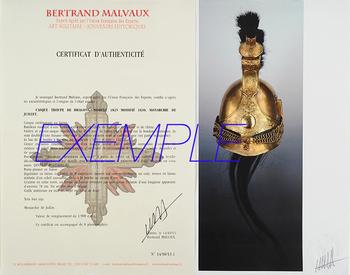
Next update Friday, december 27th at 1:30 PM
FOR ALL PURCHASES, PAYMENT IN MULTIPLE CHECKS POSSIBLE
bertrand.malvaux@wanadoo.fr 06 07 75 74 63
An authenticity certificate of the item including the description published on the site, the period, the sale price, accompanied by one or more color photographs is automatically provided for any item priced over 130 euros. Below this price, each certificate is charged 5 euros.
Only items sold by me are subject to an authenticity certificate, I do not provide any expert reports for items sold by third parties (colleagues or collectors).
